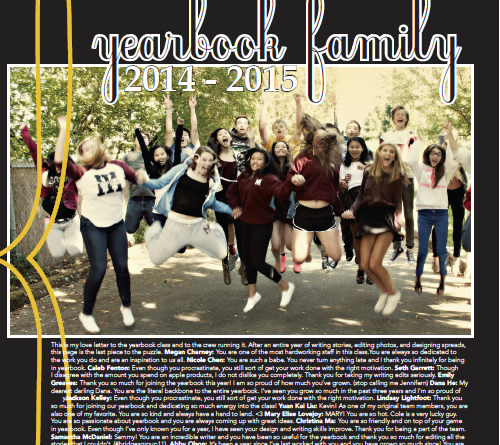
A little bird told me
Written by Elizabeth Braden, CJE
Tell others about the printing specifications of your yearbook by including a colophon.
You are at a summer workshop rummaging through yearbooks when you find it – a yearbook with a cover that would fit perfectly with the theme your staff has just selected. The colors need to be changed, but you love the look and feel of the book.
But what is this cover made of? How do you find out, so you can convey the information to your publisher?
Flip to the back of the book and find the colophon. All of the information about the production of the book should be there, such as the printer, copies ordered, fonts used, and paper and cover specifications and general acknowledgements. Many yearbooks include a colophon, but some do not.
“I’m usually disappointed if a staff doesn’t include a colophon, especially when I’m trying to figure out how a staff did something to their cover or used a cool font,” said Ronna Sparks-Woodward, adviser at Liberty High School, Liberty, Mo.
“To be honest, in the beginning, I didn’t really understand the purpose of a colophon, but I did it just because the books always had them. After a few years of doing the colophon, though, I began to see that it was a compressed record of the book, kind of like a brief description of the contents and how they were presented,” Sparks-Woodward said.
Sparks-Woodward and Lisa Morris, adviser at Carmel High School in Carmel, Ind., said their students enjoy looking through yearbooks from other schools for ideas, and they know to check the colophon for information on treatments they like.
“The most memorable example was when they saw a lenticular on the front of the 2005 Robinson Middle School book from Fairfax, Va.,” Morris said. “By checking the colophon, they not only found that the cool tip-on was called a lenticular, they found the name of the company that printed the lenticular.”
Morris said her staff has used colophons from other yearbooks for comparison, such as pricing for their size book, and to check what Carmel High staffs have done in the past.
“When a book has a colophon, you can always track down the relevant information despite staffing changes, memory lapses,” Morris said. “I may not remember what font we used in the people section in 2004, but we can look it up in the colophon if we need to. How many years have we been selling the book for $45? I’m not sure, but again, we can check a few colophons to see when the price changed.”
A colophon is not hard to include in the yearbook.
“It takes a little while to put together the colophon the first time, but after that, it is like having a template to plug new information into. The editors copy the gist of it from year to year to use as a template and then start changing it to fit their book,” Morris said. “As they work on it, they ask our rep questions like, ‘Hey, are we still using 100 lb. paper?’ and ‘What is the name of the hot foil on the cover?'”
The colophon in the Spectator at Liberty High takes up one column in the index in an effort to keep it short.
“We put the colophon separate from the staff page because it’s in our policy that staff members aren’t in the book anywhere else (unless it’s unavoidable, like if the editor-in-chief is Homecoming Queen), and the staff page is their one opportunity to be in the book other than their school picture. We don’t want to take a column away from the brief amount of recognition our staff gets, so we put the colophon at the end of the index,” Sparks-Woodward said.
Both the Spectator of Liberty and the Pinnacle at Carmel contain printing specifications, a description of how they arrived at their theme idea, photography information, awards, special thanks, complete staff list and an editors note. But there are ways to make a colophon unique.
“And really last and probably least, too, but a tradition, nonetheless: there is always a picture of one of my pet birds in our colophon. The tradition began at another school 13 years ago and has followed me to two other schools over the years,” Morris said.
Comments are closed.

